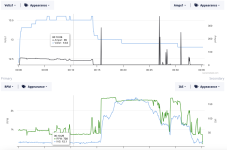bermwewjan
Member
Hi everyone,
Experienced a total electrical failure a few weeks ago and the 60A circuit breaker had popped upon inspection on the ground. We're aware that the EarthX turns off below 10.5V or whatever. We haven't been able to replicate the issue, but the flight data for some prior flights show some bizarre spikes in amps (over 300A).
We're running a new B&C LX60, with 60A circuit breaker, and EarthX battery. Any ideas on cause or other things to inspect?

Experienced a total electrical failure a few weeks ago and the 60A circuit breaker had popped upon inspection on the ground. We're aware that the EarthX turns off below 10.5V or whatever. We haven't been able to replicate the issue, but the flight data for some prior flights show some bizarre spikes in amps (over 300A).
We're running a new B&C LX60, with 60A circuit breaker, and EarthX battery. Any ideas on cause or other things to inspect?

Last edited:




